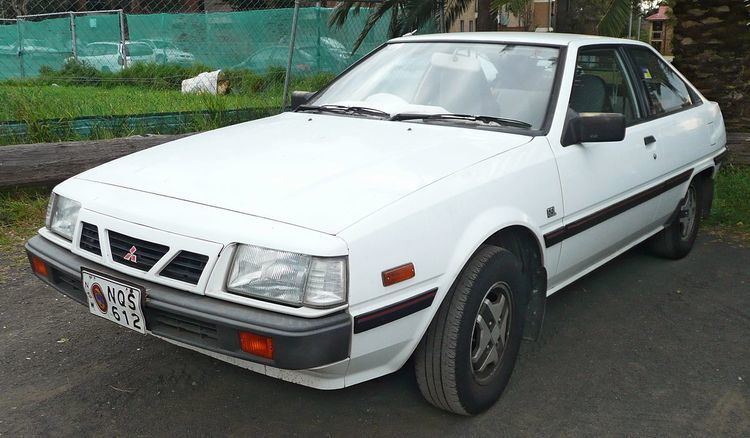Body style 3-door liftback coupé | ||
 | ||
Production 1982–1990 6213 Units produced Layout Front-engine, front-wheel-driveFront-engine, four-wheel-drive | ||
The Mitsubishi Cordia is a compact hatchback-coupé manufactured by Mitsubishi Motors from 1982 to 1990. Alongside the Tredia and Starion, it was one of the first cars imported and sold to America by the company without the involvement of its then partner, the Chrysler Corporation. In Japan, the version sold at Car Plaza retail chain was called Cordia XP, and the one sold at Galant Shop chain was called Cordia XG. The XG had a somewhat smaller front grille.
The Cordia was one of the first mass-market cars to offer an optional electronic instrument cluster.
Overview
Fitting between the existing Galant and Lancer models in Mitsubishi's range, the Cordia and Tredia used front-wheel drive and were similar in design to the contemporary Mirage (although larger). They incorporated a MacPherson strut/beam axle suspension, front disc brakes, manual or electrically controlled automatic transmission, and a choice of three engines: a 1.4-litre rated at 68 hp, a 74–87 hp (55–65 kW)1.6-litre, and a 112 hp (84 kW) turbocharged 1.6-litre. Some export markets also received a carb-fed 110 hp (82 kW) 1.6-litre. A US version of the 2.0-litre generated 88hp for the 1984 model year.
The cars received a mild facelift in 1983, and four-wheel drive was offered in 1984. The engines were modified in 1985 to allow the cars to run on unleaded fuel, including the introduction of a 1.8-litre engine in both 100 hp (70 kW) naturally aspirated and 135 hp (101 kW) turbocharged form, before production was discontinued in 1990. 1988 was its last year in the United States.
In Australia, the Cordia AA series was released in late 1983. An update, titled AB series arrived with a different grille and minor changes in 1984, and the final AC model was upgraded to unleaded gasoline in late 1985. Production ceased in 1988. Two trim levels were available, the naturally aspirated 1.8-liter GSL, and the turbocarged GSR. The early (leaded) GSRs were fitted with 13-inch alloy wheels; unleaded cars came fitted with shiny 14-inch wheels. Many Cordias suffered from poor manufacturing techniques in late models from the AB onwards as they attempted to improve it as the competition notably the AE86 and S12 had more power thus making them upgrade the old 1.6 motor into 1.8 models but the 1.8 was still quite underpowered as they refused to make it a DOHC engine due to Mitsubishi losing money on the failing subpar Tredia and putting more money into the starion and thus were in a financial struggle even though they pioneered the medium classed sports hatchback scene in the 80s for Japan and conquering the competition (which was most notably the failure that was the nissan EXA as well as the extremely dated cosmetic kit E70 sprinter) when released, thus making Nissan and Toyota to up their game on this new market and quickly extinguish this new competitor with their new sprinter from Toyota and a new Silvia from Nissan just a year later after the cordia was released, with the sprinter and silvia becoming in common with the specs of the old piazza but with a lower price and with the updated styling of the cordia as they both purchased one to improve certain aspects of it and most notably toyota took the old E70 drivetrain and slapped a new shell and engine on it to cut costs while the silvia was based on a light hatchback(which in this case was a cordia)and 300zx fusion and having the reputation of a more well known company they absolutely left Mitsubishi in the dust. Mitsubishi were also sort of flopping about as they poured money into the Starion, which did not really appeal in the export market due to Mitsubishi being a new brand to customers in the US as it was no longer rebadged as a Chrysler, and poor marketing techniques lead to the demise of Mitsubishi's three-pronged attack on the export market, while sales were slow in Japan for similar reasons.
The Cordia was assembled, alongside the Tredia on which it is based, in New Zealand by Todd Motors, later Mitsubishi New Zealand. The cars were imported as CKD kits and were built with about 40% local content including glass, upholstery, carpet, wiring harnesses and radiators. Both normally aspirated and turbocharged versions were made. All models were initially 1.6-litre but the normally aspirated model was later changed to a 1.8-litre engine at the same time as the original 4x2 Super Shift manual transmission was changed to a conventional five-speed gearbox. Normally aspirated models were also offered with a conventional three-speed automatic gearbox.
